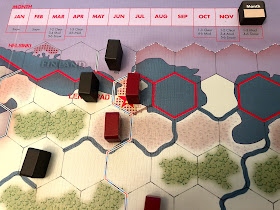 |
| Photo: Wizard Kings 2nd Edition by Columbia Games |
What happens when you combine the theme and diversity of a fantasy RPG with the game mechanics and elegance of a block war game? You get Wizard Kings, Columbia Games unique fantasy-based block game (1st Ed. published in 2000, 2nd Ed. in 2006). From Columbia’s website:
Wizard Kings is an exciting fantasy battle game with armies of elves, dwarves, orcs, undead, and three human armies (feudal, barbarian, amazon). Players customize their armies and fight for control of strategic cities and terrain on geomorphic maps.
The base set for the game includes:
- 4 geomorphic maps which connect in hundreds of different ways.
- 7 Armies: Elves, Orcs, Dwarves, Undead, Barbarians, Feudals, Amazons. Base game comes with an assortment of all armies.
- Wizard Kings Rules
- 4 dice
Game turns are standard fare for those already familiar with other block games. They are made up of the following four phases:
- Initiative Phase
- Move Phase
- Combat Phase
- Build Phase
The game itself is fast-paced, with shorter scenarios often lasting only 10 turns and requiring about an hour to complete. There is also a solitaire scenario included in the base set, though the game is designed for 2-7 players.
Wizard Kings should appeal to both fantasy RPG fans as well as block war gamers. With its armies of orcs, elves, and dwarves (to name just three), the game captures the spirit of Tolkien’s Middle Earth, or possibly even Chainmail, Gary Gygax’s miniatures & fantasy precursor to Dungeons & Dragons.
However, Wizard Kings still employs the tried and true Columbia block system for combat with its step losses, combat ratings, fog of war, and dice rolls for resolving battles. Additionally, each army is equipped with their own unique Wizard, capable of spellcasting in either the Move or Combat phase.
However, Wizard Kings still employs the tried and true Columbia block system for combat with its step losses, combat ratings, fog of war, and dice rolls for resolving battles. Additionally, each army is equipped with their own unique Wizard, capable of spellcasting in either the Move or Combat phase.
Wizard Kings introduces players to an entertaining game system, but one which also has great versatility and replayability thanks in part to expansion sets containing 21 additional blocks each. While the base set contains 4 geomorphic maps which allow for mixing and matching and customizing scenarios, Columbia Games also sells three additional map packs with 4 maps each to further increase versatility.
At this point I have only tried a few basic two player scenarios, both of which are available in the 8 page rule book. Each one has been outstanding so far. There are real strategic decisions to be made: coordinating movement and attacks; use of build points to either strengthen existing blocks or to introduce new ones onto the board; when (and how best) to use your wizard, as each spell cast also results in at least one step loss; and how to maneuver across the geomorphic map(s) with all of their terrain effects, stacking limits and hexside limitations.
After only a few games in and this has already become my son’s favorite block war game. The theme is perfect to capture his young imagination, aided by the quality of the components, particularly the outstanding block label art and detailed maps. Wizard Kings is a game that will no doubt get a great deal of table time in our house.
Photo credit: Brian Williams













